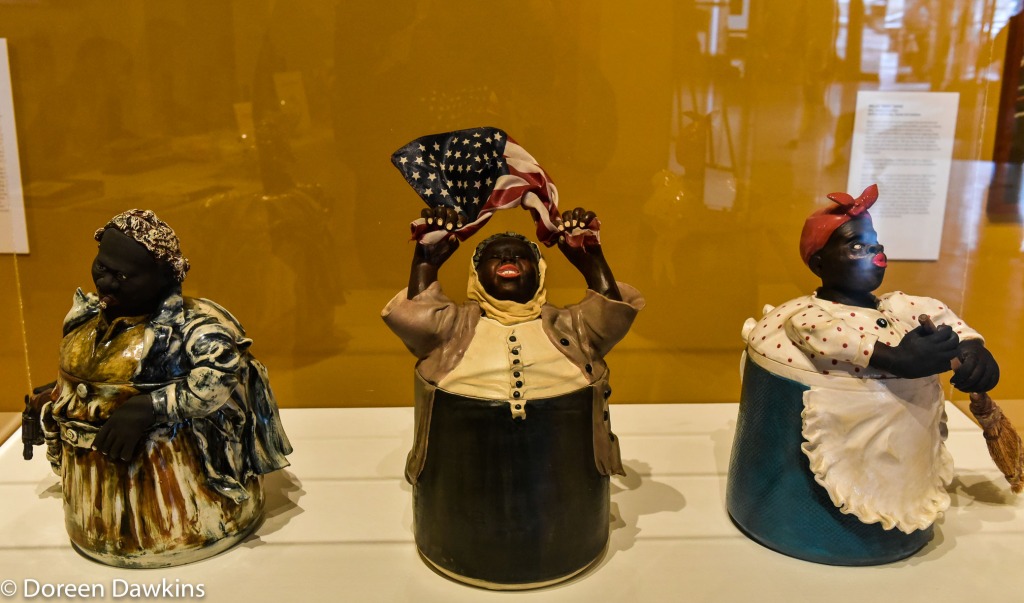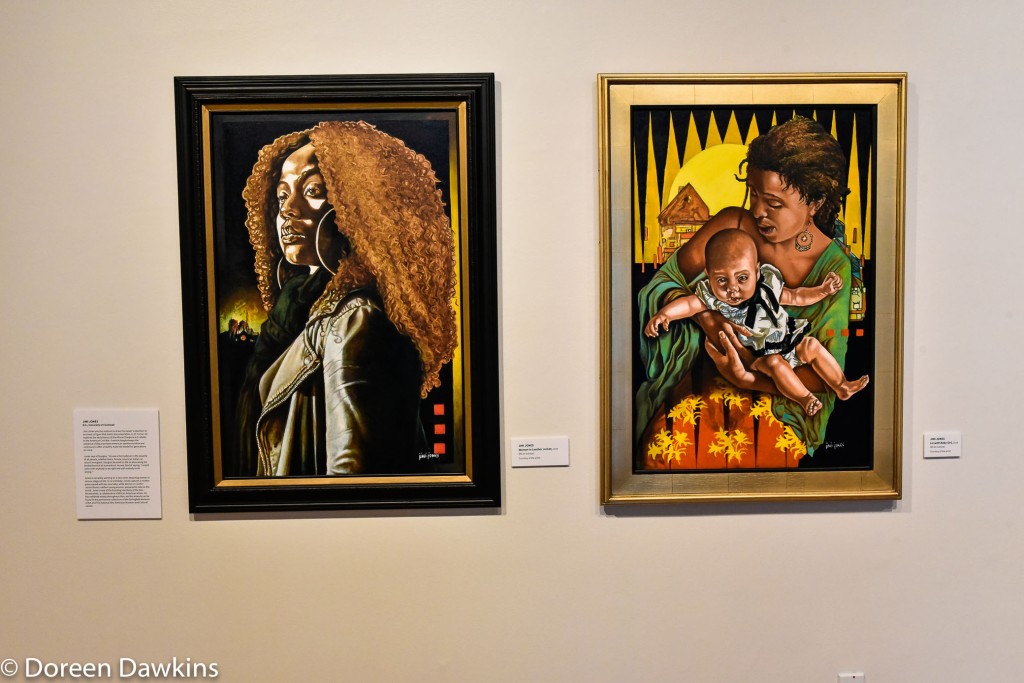Location: Riffe Gallery, 77 S. High Street, Columbus, OH 43215

Tell me about your background, your title, and what you do.
I am the lead curator at the National Afro-American Museum and Cultural Center in Wilberforce Ohio. I was born in the Dominican Republic. My family migrated to New York when I was one. I migrated to Columbus, Ohio with my immediate family. I have been here 25 years. I came out here to work in the design department at the Ohio Historical Society (now called the Ohio History Connection).
I have a Bachelor of Fine Arts from The Cooper Union. My concentration was graphic design, but I did a lot of print making and fine arts classes. After that, I worked at the Aquarium for Wildlife Conservation in Brooklyn. I worked in the design department here for 21 years. During that time, I was also curating works and exhibits in the community because there was a void for people of color doing this work. When I first moved here, my goal was to make it as a designer and to claim a name for myself and then go back to New York. I thought I needed to be more instrumental here because New York is already established in multiculturalism.
I got involved with a Latino non-profit group called the Latin Ladies. This launched me into the leadership of a non-profit. I was elected Vice President of that group. From there, I was nominated and brought on to the Ohio Latino Arts Association. I eventually became the Vice President of that group. Then, I spring boarded to the National Association of Latino Arts and Culture. They helped me to see what was possible. Their headquarters is in San Antonio, Texas. I was selected for a national leadership Institute. I saw Latino Groups that were far more established and what was possible for artists of color. I came back here and started the Latino Arts for Humanity. After working with that group for a few years, I realized that I needed to reach more artists. Growing up in New York was about being with everyone from everywhere. My block in Queens was like the UN (United Nations). I didn’t want to limit myself to only working with the Latino community. I started the non-profit Creative Culture. That group allowed me to organize and curate exhibits that were more inclusive.
I became friends with local African American artists as well as all artists. I would try to include my friends in exhibits that I was asked to do. Once local organizations that have gallery space want some diversity, as a curator of color, then I become the go to person. Then the position for curator was open at the National Afro-American Museum and Cultural Center. It is one of the sites within the site system for the Ohio History Connection. I started that position four years ago. Because I was known for curating in the Columbus community, Mary Gray who was the director of the Riffe at the time saw me at another opening and asked if I was interested in collaborating. Because I am full time at the National Afro-American Museum and Cultural Center, it makes sense to highlight the artists we have in our collection that are still living in Ohio today. Then we added a few other artists that have won the individual artist Excellence award from the Ohio Arts Council.
All the pieces in the exhibit were handpicked. I did studio visits. I had long conversations with the artists to make sure that I am representing them the way that they want to be represented. I want to show as much of the evolution of their work as possible. It can be what they have been known for or how they started their work and how their style has evolved, and where it is at today or they can just show where they are today and the new body of work. Most are the evolution of their style or content.
Once the pieces are in the space, it is a matter of how they talk to each other and the energy that the pieces bring when they are next to each other. Sometimes you must make last minute corrections. Cat Sheridan (Director of the Ohio Arts Council’s Riffe Gallery) was instrumental in that. We laid out where we thought the pieces would best work based on size, contrasts, and color. An active piece and passive piece must be displayed in such a way that each one is going to get the respect that they need, so that each artist work stands out. Even though a piece right next to it is from another artist, when it comes to seeing it on the wall, it will feel like you are only looking at that artists’ work.
My goal as a curator is to be the bridge between the public and our institutions.
What advice would you give a young person who wants your job?
At the National Afro-American Museum and Cultural Center, we focus on two areas. We have two big galleries. One has a history exhibit, the other usually has an art exhibit. I am the curator for both sides. You usually will not find curators who can do both because it is two different studies. I can do both because I have been working at a history museum for over 20 years and my background is in fine arts. The two other curators who work on my team have backgrounds in public history. Because these jobs are so sought after, everyone within the Ohio History Connection has a master’s degree. Your bachelor’s degree should be in fine arts for the art side. Your bachelor’s degree should be in history for the history side.
The best advice I can give a young person is to get connected or affiliated with a museum, an exhibit space, or a gallery space. Start by interning or volunteering. That is education that you don’t have to pay for. Also, think about who you will train under. For example, I was born to mentor. I won’t hold anything back. I want everyone working under me to succeed. I will teach them everything I know. That is not the case with everyone. With any mentor you should learn how to hang a work of art, how to handle art, how to measure, etc. At the end of the day, if you feel like you aren’t getting much more than that, leave and find another mentor. If you have one bad experience, don’t give up. When you start out, you must do a lot of grunt work. But, if you are only doing grunt work that is demoralizing.
How are the descriptions next to the works of art created?
There are different ways that it can come about. In this case, it was part of my job to come up with artist statements for each of the artist groupings. I was given a word count, because it all had to have one voice. It is our mission at the National Afro-American Museum and Cultural Center to represent first voice for artists and historical figures. I worked from the submitted artist statements. Some people submitted a couple of sentences and some people submitted pages. I included a quote in their first voice, in each of the statements. If someone submitted a sentence or two that wasn’t in the style of information, then I supplement that with what I know about their artwork. I can talk about why I chose them, what is interesting or stands out or what is different about their work versus another person’s work.
Anything else?
As a curator, I want to get to know each of the artist because if I outlive them, I want to make sure that their legacy lives on. I am still telling their stories and I am talking about their work.
Here are a few pieces that I was drawn to:


“Tracy Ameen is internationally known for her sculpting and double wall pottery, a rare form of art dating to the Chinese Ming Dynasty”.

“The two masks were created years apart, yet Davis returns to the use of objects to create contemporary masks in response to observations in his environment.



Sidebar: The next article will be on Queen Brooks. As part of our interview, she explained both pieces. To see more of Queen Brook’s work and the interview click on the following link: https://614whats2love.com/2020/02/25/artist-queen-brooks/


Sidebar: I have lived in Columbus all my life. I even worked downtown for a few years. I didn’t know there was a gallery in the Riffe building.